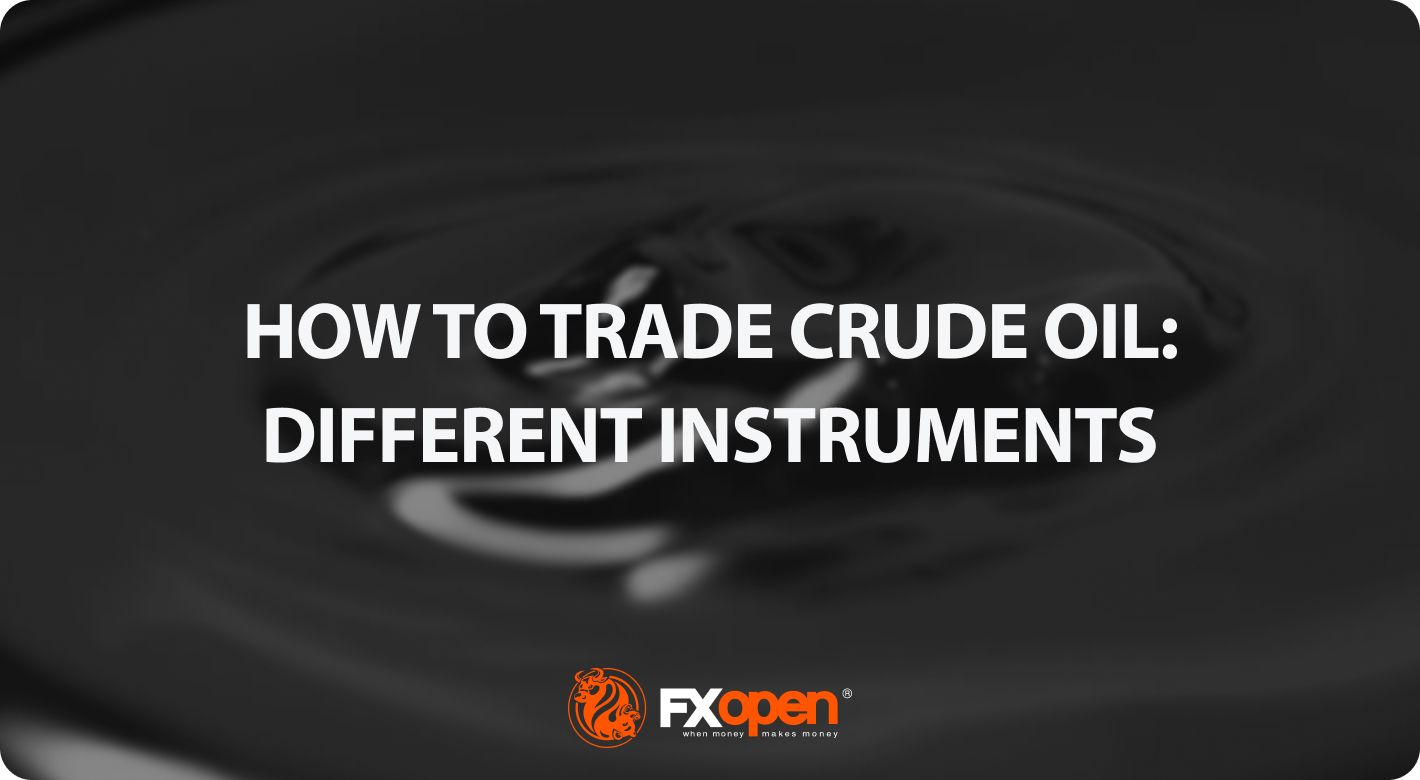FXOpen

Crude oil is a dynamic and complex market, offering traders various instruments for participation. With opportunities for both short-term and long-term investment, it presents multiple avenues for exciting trading. This article delves into the different financial instruments available for crude oil trading profit, from CFDs to ETFs and everything in between.
Why Trade Crude Oil?
Crude oil, particularly its major benchmarks Brent Crude and West Texas Intermediate (WTI), is a highly traded commodity known for its significant liquidity and price volatility. These attributes make it attractive for traders looking to capitalise on price movements in either direction.
These markets operate nearly around the clock, accommodating traders across time zones. The best time to trade crude oil is usually during the overlap of the New York and London market hours, where liquidity is at its highest, facilitating more efficient trades.
Key Factors Affecting Market Prices
Understanding the forces that influence crude oil prices is essential. Geopolitical events, supply and demand dynamics, and economic indicators like inflation rates all play a role. Natural disasters affecting refineries or pipelines can also cause price fluctuations. For those keen on technical analysis, crude oil trading signals, which use past price data to predict future movements, can be an additional tool in a trader's toolkit.
CFDs
Contracts for Difference (CFDs) are popular instruments when trading crude. CFDs are used by traders to trade on price movements without owning the underlying asset. Essentially, a CFD is a contract between a trader and a broker to exchange the difference in price from the point the position is opened to when it is closed. One of the key benefits is the use of leverage, which means traders can control a larger position with a smaller initial investment, amplifying both potential profits and losses.
Margin requirements vary by broker but are typically lower for CFDs compared to other instruments. This makes it appealing for crude oil day trading strategies, where traders aim to capitalise on short-term price movements. However, managing risk effectively is crucial, as the leveraged nature of CFDs can result in significant losses if the market moves against you.
To make the most of the opportunities in crude oil, trading software like FXOpen’s free TickTrader can help. Head over there to explore a world of trading tools and other assets beyond crude oil.
Futures
Futures contracts are another well-established avenue for trading crude oil. Unlike CFDs, futures are standardised agreements to buy or sell a specific quantity of oil at a predetermined price at a set date in the future. They are traded on regulated exchanges, providing an added layer of transparency and security. Each contract comes with specific terms, such as the quality and expiration dates.
Day trading oil futures involves buying and selling contracts within the same trading day to capitalise on short-term price fluctuations. It's a strategy that requires keen attention to market trends and a good understanding of leverage, as futures also allow market participants to control large positions with relatively small capital. Keep in mind that futures are subject to rollover, meaning market participants can move their positions to the next contract to cash or delivery settlements.
Spot Market
In spot trading, one buys or sells crude oil and takes immediate delivery and ownership. Unlike futures and CFDs, there's no leverage in spot trading, making it a less risky option. However, the absence of leverage requires a higher initial investment. While retail traders often avoid spot trading due to storage and transportation challenges, it's commonly used by entities directly involved in production or consumption. This method is more straightforward but demands the logistical capabilities that individual traders usually lack.
ETFs
Exchange-traded funds (ETFs) offer an alternative for those interested in the crude oil market without dealing with futures contracts or physical ownership. Crude oil ETFs typically track the price of oil or related indices by holding futures contracts or a blend of oil company stocks. This allows investors to indirectly gain exposure to oil price movements with less complexity.
Investing in a crude oil ETF can provide a degree of diversification, as these funds may also include assets like bonds or other commodities in their portfolio. However, it's essential to be aware of the management fees and potential tracking errors in the ETF's performance compared to the actual commodity.
Stocks
Another route to gain exposure to the crude oil market is by investing in the stocks of companies involved in the industry. This includes major producers, refineries, and even transportation companies. By owning shares in these businesses, investors are indirectly influenced by crude oil prices. To use an example, a rise in oil prices often boosts the profitability of oil-producing companies, potentially leading to stock price appreciation.
Unlike trading futures or CFDs, investing in stocks means actually owning a piece of the company, often with the added benefits of dividends. However, conducting thorough research is crucial, as these stocks can be affected by company-specific risks in addition to oil price movements.
The Bottom Line
Trading crude oil offers various avenues, each with its unique risk profile and investment requirements. From CFDs and futures for the more active traders to ETFs and stocks for those seeking longer-term investment, there's an instrument suited to every trading style. To get started with crude oil CFDs, consider opening an FXOpen account to access both Brent Crude oil and WTI oil.
This article represents the opinion of the Companies operating under the FXOpen brand only. It is not to be construed as an offer, solicitation, or recommendation with respect to products and services provided by the Companies operating under the FXOpen brand, nor is it to be considered financial advice.
Stay ahead of the market!
Subscribe now to our mailing list and receive the latest market news and insights delivered directly to your inbox.








